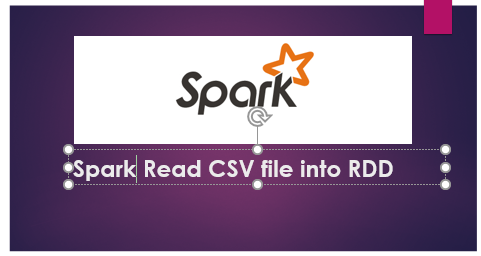In this tutorial, I will explain how to load a CSV file into Spark RDD using a Scala example. Using the textFile() the method in SparkContext class we can read CSV files, multiple CSV files (based on pattern matching), or all files from a directory into RDD [String] object.
Before we start, let’s assume we have the following CSV file names with comma delimited file contents at folder “c:/tmp/files” and I use these files to demonstrate the examples.
| File Name | File Contents |
|---|---|
| text01.csv | Col1,Col2 One,1 Eleven,11 |
| text02.csv | Col1,Col2 Two,2 Twenty One,21 |
| text03.csv | Col1,Col2 Three,3 |
| text04.csv | Col1,Col2 Four,4 |
| invalid.csv | Col1,Col2 Invalid,I |
- Read CSV file into RDD
- Skip header from CSV file
- Read multiple CSV files into RDD
- Read all CSV files in a directory into RDD
Load CSV file into RDD
textFile() method read an entire CSV record as a String and returns RDD[String], hence, we need to write additional code in Spark to transform RDD[String] to RDD[Array[String]] by splitting the string record with a delimiter.
The below example reads a file into “rddFromFile” RDD object, and each element in RDD represents as a String.
// Read from csv file into RDD
val rddFromFile = spark.sparkContext.textFile("C:/tmp/files/text01.csv")
But, we would need every record in a CSV to split by comma delimiter and store it in RDD as multiple columns, In order to achieve this, we should use map() transformation on RDD where we will convert RDD[String] to RDD[Array[String] by splitting every record by comma delimiter. map() method returns a new RDD instead of updating existing.
// Applying map() on Rdd to get array[string]
val rdd = rddFromFile.map(f=>{
f.split(",")
})
Now, read the data from rdd by using foreach, since the elements in RDD are array, we need to use the index to retrieve each element from an array.
// Read data from RDD using foreach
rdd.foreach(f=>{
println("Col1:"+f(0)+",Col2:"+f(1))
})
Note that the output we get from the above “println” also contains header names from a CSV file as header considered as data itself in RDD. We need to skip the header while processing the data. This is where the DataFrame comes handy to read CSV file with a header and handles a lot more options and file formats. Spark’s DataFrame API or other libraries like Apache Spark’s built-in spark-csv library or external libraries like dataframes-csv provide more effective and efficient ways to work with CSV files.
// Output:
Col1:col1,Col2:col2
Col1:One,Col2:1
Col1:Eleven,Col2:11
Let’s see how to collect the data from RDD using collect(). In this case, collect() method returns Array[Array[String]] type where the first Array represents the RDD data and inner array is a record.
// Collect data using collect()
rdd.collect().foreach(f=>{
println("Col1:"+f(0)+",Col2:"+f(1))
})
This example also yields the same as the above output.
Skip Header From CSV file
When you have a header with column names in a CSV file and to read and process with Spark RDD, you need to skip the header as there is no way in RDD to specify your file has a header.
// Skip the header of CSVFile rdd.mapPartitionsWithIndex { (idx, iter) => if (idx == 0) iter.drop(1) else iter }Read Multiple CSV Files into RDD
To read multiple CSV files in Spark, just use textFile() method on SparkContext object by passing all file names comma separated. The below example reads text01.csv & text02.csv files into single RDD.
// Read multiple CSVFiles into RDD
val rdd4 = spark.sparkContext.textFile("C:/tmp/files/text01.csv,C:/tmp/files/text02.csv")
rdd4.foreach(f=>{
println(f)
})
Read all CSV Files in a Directory into RDD
To read all CSV files in a directory or folder, just pass a directory path to the testFile() method.
// Read all CSVFiles in a directory
val rdd3 = spark.sparkContext.textFile("C:/tmp/files/*")
rdd3.foreach(f=>{
println(f)
})
Complete example
package com.sparkbyexamples.spark.rdd
import org.apache.spark.rdd.RDD
import org.apache.spark.sql.SparkSession
object ReadMultipleCSVFiles extends App {
val spark:SparkSession = SparkSession.builder()
.master("local[1]")
.appName("SparkByExamples.com")
.getOrCreate()
spark.sparkContext.setLogLevel("ERROR")
println("spark read csv files from a directory into RDD")
val rddFromFile = spark.sparkContext.textFile("C:/tmp/files/text01.csv")
println(rddFromFile.getClass)
val rdd = rddFromFile.map(f=>{
f.split(",")
})
println("Iterate RDD")
rdd.foreach(f=>{
println("Col1:"+f(0)+",Col2:"+f(1))
})
println(rdd)
println("Get data Using collect")
rdd.collect().foreach(f=>{
println("Col1:"+f(0)+",Col2:"+f(1))
})
println("read all csv files from a directory to single RDD")
val rdd2 = spark.sparkContext.textFile("C:/tmp/files/*")
rdd2.foreach(f=>{
println(f)
})
println("read csv files base on wildcard character")
val rdd3 = spark.sparkContext.textFile("C:/tmp/files/text*.csv")
rdd3.foreach(f=>{
println(f)
})
println("read multiple csv files into a RDD")
val rdd4 = spark.sparkContext.textFile("C:/tmp/files/text01.csv,C:/tmp/files/text02.csv")
rdd4.foreach(f=>{
println(f)
})
}
This complete example can be downloaded from GitHub project
Conclusion
In this tutorial you have learned how to read a single CSV file, multiples CSV files and reading all CSV files from a directory/folder into a single Spark RDD. You have also learned how to skip the header while reading CSV files into RDD.
Happy Learning !!
